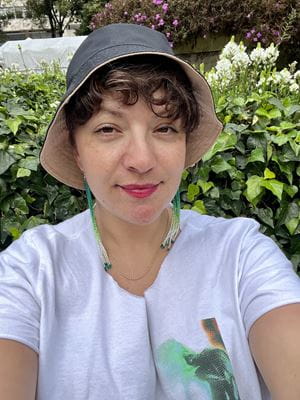
Why is it so important to grieve together?
 by Jon Kuiperij – Apr 26, 2023
by Jon Kuiperij – Apr 26, 2023  In Take 5, Sheridan’s thought leaders share their expert insight on a timely and topical issue. Learn from some of our innovative leaders and change agents as they reflect on questions that are top-of-mind for the Sheridan and broader community.
In Take 5, Sheridan’s thought leaders share their expert insight on a timely and topical issue. Learn from some of our innovative leaders and change agents as they reflect on questions that are top-of-mind for the Sheridan and broader community.
 Next month, Sheridan creativity professor Fran Quintero Rawlings and several other Toronto-based artists will launch an interactive public art installation that aims to destigmatize expressions of grief. “Space for Grief” will be open to the public at the Toronto Reference Library, 789 Yonge Street, from May 1-9.
Next month, Sheridan creativity professor Fran Quintero Rawlings and several other Toronto-based artists will launch an interactive public art installation that aims to destigmatize expressions of grief. “Space for Grief” will be open to the public at the Toronto Reference Library, 789 Yonge Street, from May 1-9.
In this installment of Take 5, Quintero Rawlings discusses her research into how western society processes death and grief, the importance of communicating and validating emotions associated with grief, the value of a supportive community and more.
1. What prompted you to conduct research into western society’s approach and response to death and grief?
I’ve always been curious about why our society doesn’t talk openly about death and grief, even though we fully understand that we’re all going to die one day. Death is inevitable, yet something that is so absolute, so tangible and very much a part of the human journey feels so detached from our conversations.
I chose to explore this mystical topic in 2019 as my dissertation for my Master of Design in Strategic Foresight & Innovation degree studies at OCAD University. Not only did grief and death seem like a space that is ripe for innovation, it was also something I personally wanted to better understand and prepare myself for.
Once I began exploring, I couldn’t stop reading about it. I also found that once I started talking about this topic with others, everyone else wanted to talk about it because there weren’t many spaces, places or opportunities to have these types of conversations. It really opened people up and often served as a release.
2. Death and grief are often associated together, but what else can cause prolonged, complicated grief or feelings of loss?
Grief isn’t limited to the death of a loved one or things that can happen in our day-to-day lives, such as the loss of a job or the ending of a relationship.
One example is the newcomer experience, starting over in a new country where things are very different. We often don’t think about the grief associated with adapting to a new culture, a new language, a new climate. It’s especially difficult for someone who may have been a doctor or a lawyer in their home country but is now expected to do the lowest-paying jobs and has to re-establish their own sense of identity.
There’s also grief in the postsecondary student experience. Something that isn’t talked about often or researched a lot is how many students go from being seen as children or teenagers in high school to suddenly being seen as adults with a lot of responsibility. It can be exciting to become independent, but it can also be really challenging to transition to that loss of childhood, the loss of the way things were.
Then there’s collective grief, such as how we all suddenly lost our ways of life during the COVID-19 pandemic, or when the thousands of bodies of Indigenous children were found on the grounds of former residential schools.
3. Why is it so important to complete the grieving process?
Just like we love to celebrate our achievements, we also need to process our feelings when something traumatic or sad happens. When you don’t allow yourself to complete that process, there are many consequences that can manifest physically and mentally over time.
There are also many social issues that are connected with grief. For instance, addiction can become a coping mechanism for unresolved grief, and grief can be a major factor that may lead someone to experience homelessness. If a person does not find healthy ways to express and process their grief, they may experience a buildup of emotions that can lead to a range of negative behaviours, including anger, aggression and even violence.
4. Are there any common mistakes in how western society approaches grief or supports others who are grieving?
My father passed away during the pandemic and I — someone who had studied grief for a year and am privileged to have the support of a wonderful husband and a community and so many resources — still felt like I could barely cope. I felt so unprepared to handle it, not only emotionally but also logistically. Imagine someone who may not have those supports in their lives.
“That’s something that is misunderstood about the Elisabeth Kübler-Ross model of the five stages of grief: it was written from the perspective of someone who was dying, not from the bereaved. Grief is forever. We’ll always miss the people that we love.”
During my master’s research, I spoke to one woman who had lost her daughter and her husband in a car accident. She noted how people are always afraid to bring it up in conversation with her, as if it was going to make her think about it. She told me that she’s ‘always thinking about them’. That’s something that is misunderstood about the Elisabeth Kübler-Ross model of the five stages of grief (denial, anger, bargaining, depression and acceptance): it was written from the perspective of someone who was dying, not from the bereaved. Grief is forever. We’ll always miss the people that we love.
When someone is grieving, they may not want to be around other people or want anything from anyone, but it’s still very important that people are checking in on them. That can do so much for their soul. Some religions and cultures do this very well, such as Islam’s 40 days of mourning or Judaism’s seven-day mourning period, called “shiva”.
Being with people and holding them up when they’ve lost something is so foundational. If I can laugh with you and I can talk with you, why can’t I cry with you as another form of natural human expression? Grief is ultimately about being seen and heard.
5. What did you and your colleagues consider when designing Space for Grief?
We were really inspired by the temple that sits at the center of Black Rock City, a temporary metropolis that people gather to create during the annual Burning Man event in Nevada. That temple is truly inclusive, a space where people can share solemn experiences of solidarity that aren’t tied to any religion.
What’s really beautiful is that the artist team behind this project all come from different backgrounds, belief systems and different worldviews, similar to the makeup of the city around us. It was important to find ways to incorporate all the beauty of these differences while finding commonalities in what may be meaningful in this space. Part of this process has also been discovering common language and common ways in which to support each other, especially for people who previously haven’t had places or spaces or communities or families to grieve with.
“It's so fitting that the installation is in a library, one of the few free spaces left in our society where people of all walks of life can go. Space for Grief is about welcoming everyone.”
The Space for Grief installation includes spaces for reflection, contemplation and letting go. In the reflection space, we incorporated natural organic elements such as flowers and plants, not only because most cultures engage with those elements during times of grief, but also because it’s been proven that spending time in nature is good for our mental health. Fire is represented in the contemplation space to honour its importance in the grieving process and the sense of community many of us feel when sitting around a fire. Letting go is symbolized in a space where people can write messages onto paper birds that will then be hung up high, sharing those messages for everyone to see.
It’s also so fitting that the installation is in a library, one of the few free spaces left in our society where people of all walks of life can go. Space for Grief is about welcoming everyone.
Fran Quintero Rawlings is a designer, educator, artist and researcher. She is the co-founder of Method Collective, a boutique consultancy that specializes in futures, foresight, UX, strategy and design, exploring the way humans behave and interact with systems, environments, technology and each other. Fran is also an adjunct professor in Sheridan’s Creativity and Innovation curriculum. In 2019, she completed her Master of Design at OCAD University, where her master’s thesis explored designing more inclusive death and grief practices in western culture. Fran also holds a broadcast journalism and film advanced diploma from Centennial College, a social economy certificate from the University of Toronto, and a bioengineering and biomedical engineering certificate from Harvard University. In her spare time, Fran loves to read, go bouldering and dance.
Interested in connecting with Fran Quintero Rawlings or another Sheridan expert? Please email communications@sheridancollege.ca
This interview has been edited for length and clarity.
Media Contact
For media inquiries, contact Sheridan’s Communications and Public Relations team.



